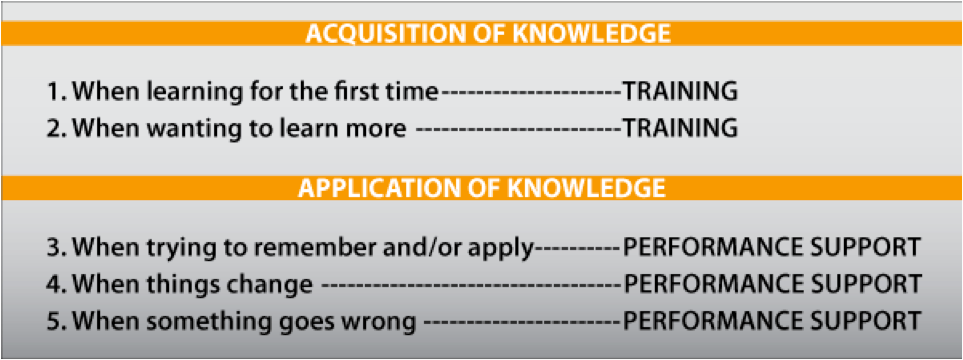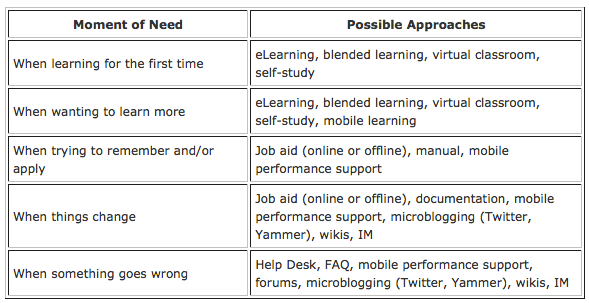Pure Performance Is Efficient (And Effective!)
Joe walks in, he is harried fresh from the Operations floor and he opens up the discussion saying, “look, I need a 4 hour class and I can tell them all they will need to know…” and continues until he closes with “and we’ll videotape it so others can watch it later”. Have you ever had that experience? What does it take to move the meeting meter from education to training to learning to social to performance to … living successfully?
 Gary Wise stated that training “has a call-to-action to broaden scope and charter to the extent that they can treat the entire learning environment – edge-to-edge. This edge-to-edge environment represents something that is unique to every organization – a dynamic, learning ecosystem.”
Gary Wise stated that training “has a call-to-action to broaden scope and charter to the extent that they can treat the entire learning environment – edge-to-edge. This edge-to-edge environment represents something that is unique to every organization – a dynamic, learning ecosystem.”
I think the time is right 4Square, FB, Tweet, Pinterest, OpenTable and app-way to finding the solution to the problem we have at the point of need. We need to focus our efforts on supporting our users effectively and efficiently by revisiting Conrad Gottfredson’s 5 moments of learning needs:
- When learning for the first time
- When wanting to learn more
- When trying to remember
- When things change
- When something goes wrong.
Straight lecture, weeks of 8 hour classes, talking heads on a screen all of these create an overload of data that people cannot retain, much less use and apply since they are not able to use the newly gained knowledge before they lose it. So let’s look again at the 5 moments as our job aid and frame our solutions on the mobile, “smart” (phone) people we support.
 While mobile can be most effective in performance support it is appropriate for all 5 moments, if the design model includes reusable objects you can re-purpose, re-use, review and renew your learners. The primary objective is to be effective while being efficient, whether content being acquired is self-directed or business enforced learners want to get to the “how do I…” (aka WIIFM) as fast as possible. We know good design focuses on meeting the moment of need so let’s not add in too much, the rest is commentary and can be placed for additional searching when, and if, needed on a web site.
While mobile can be most effective in performance support it is appropriate for all 5 moments, if the design model includes reusable objects you can re-purpose, re-use, review and renew your learners. The primary objective is to be effective while being efficient, whether content being acquired is self-directed or business enforced learners want to get to the “how do I…” (aka WIIFM) as fast as possible. We know good design focuses on meeting the moment of need so let’s not add in too much, the rest is commentary and can be placed for additional searching when, and if, needed on a web site.
If they are searching they are already motivated so we can reduce the context and introductions. We can focus on the need, focus on the solution and get to the point. While never replacing eLearning and the classroom we do need to “Think outside the course (TOTC)” and integrate support tools, such as mobile, into the learning ecosystem (even within the classroom!).

(via the eLearning coach: Working With The Five Moments Of Need)
If we focus on efficient let’s use to the November 2007 post by Bob Mosher and Conrad Gottfredson where they described a solution (What Is “Intuitive, Tailored Aid”?) that efficiently provides support to an individual. To summarize, aids (whether job, performance, and/or communication tools) are:
- intuitive
- readily and logically available, easily accessible
- simple, straightforward, and role-based
- directly mapped to the way a person actually perform
- integrated to allow deep diving
The bottom line is effective. And that is one conversation clients rarely ever have for it is all about defining success and the metrics that measure it. If looking at the first 2 learning moments we can increase efficiency by providing pre-tests, let them test out (certainly have their attention if they don’t pass, failure is a different type of motivation!). For the other three learning moments use tests and quizzes as content reinforcement and force the user to demonstrate their ability to synthesize and apply the knowledge. Make it quick, make it fast, make it all about the problem at hand and stay focused.
Seymour Papert, author of Mindstorms: Children, Computers and Powerful ideas, is attributed with saying, “You can’t teach people everything they need to know. The best you can do is position them where they can find what they need to know when they need to know it.” The lesson for me is to focus on what the person needs to perform the task at hand and/or accomplish their goal as efficiently and effectively as possible. Stay away from adding layers of content they don’t need, stay away from adding context beyond the basics, stay away from glitzy and media-rich elements since that takes time to load and eats up monthly data minutes. Keep is simple, and they will be successful!

